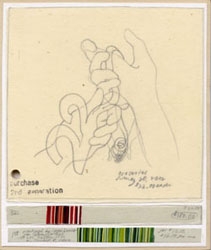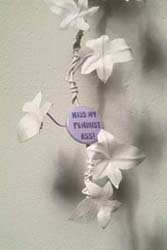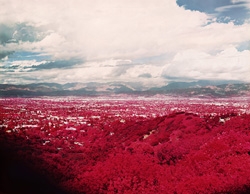
Summer (2002) (detail), Danica Phelps, Dimensions variable Courtesy the artist and Zack Feuer Gallery
Feature: Reviews
Particulate Matter
- Mills College Art Museum
- Oakland, California
- September 9 ‐ December 10, 2006
Reviewed by Greg Borman
Particulate Matter brings together six American and European artists. Three of the artists operate out of Los Angeles, which is all too appropriate. L.A. is regularly ranked as the most polluted city in the U.S., due in no small part to its high levels of tiny, airborne solids and aerosols (i.e., particulate matter). So, for the purposes of this show, how should we define particulate matter? In his catalog essay, guest curator Glen Helfand asks us to think of it metaphorically. He writes that we are in an era where many aspects of life — the environment, global political events — are on the verge of potentially irreversible change. While acknowledging that the artists in Particulate Matter possess political awareness, Helfand points out that they are just as likely to be inspired by personal concerns.
Of all the work on display, Florian Maier-Aichen’s photographic tricks best embody the environmental aspect of what Helfand refers to as “pervasive cultural tumultuousness.” In Untitled (Mulholland), a convincingly rendered, blood red plant has taken over most of an expansive L.A. landscape. Closer inspection reveals that the buildings are uniformly white, another sign that things are in mutational mode. Whether achieved in the darkroom or digitally, Maier-Aichen’s subtle manipulations show considerable skill.
Danica Phelps’s pencil line drawings, diagrams, and lists combine to impart an oddly detached presentation of her daily life. Briefly noted excursions with a new girlfriend, time spent in the studio, and parking expenses while running errands in her home base of New York City are among the details listed in the works here. Phelps often illustrates a singular activity with simple, overlapping outlines, injecting some much‐needed personality into the numbing recording of events. One such drawing shows a car’s fuel gauge pointing to empty. Over this, a superimposed image of a finger being bitten by a nervous mouth is drawn, cleverly conveying a sense of oncoming panic.
Karl Haendel’s work involves a labor-intensive method of appropriation. The artist and studio assistants reproduce images and text, using pencil. Drawings of air conditioners bring to mind daily news of environmental crisis, while a newspaper article describing a ludicrous attempt to help World War II dogs survive on the battlefield seems in keeping with the fuzzy logic of a current wartime President. On one drawing, Haendel has scribbled a dedication to Mel Carnahan and Paul Wellstone, two progressive politicians who met early deaths in separate plane crashes.
In her 2006 series Political Slogans and Flower Magick, Andrea Bowers looks mainly to organized feminist activity of the recent past as a point of reference. Five wall‐mounted sculptures, each made with an earnest crafts approach, are renditions of various flowers and weeds. Fastened to the wiry vines of each piece is a small button, sporting a lone visceral phrase or image. “Kiss My Feminist Ass!” is printed in dark purple with a 1960s retro font on one button, humorously contrasting with the innocuously decorative vines that creep all the way across one wall, and down an adjoining one.
Seven watercolors on paper by Pamela Wilson‐Ryckman are tacked directly to the wall, offering a casual touch in the museum setting. Her work seems veiled in mystery, with its muted colors and slight contrasts. Working from news photos, Wilson‐Ryckman has chosen images — oil platforms in bodies of water, large crowds of people in public areas — that are generalized, and as such they bring to mind numerous current events simultaneously.
Chris Finley feeds a lot of information into computer programs, and goes about reproducing the strange results in acrylic ink and graphite. Sloth Hammer features a complex web of earth tone shapes that imply frantic motion. While the exhibition catalog informs us that photographs of Hollywood figures Mel Brooks and Morgan Freeman, sculptor Henry Moore, and musician Liz Phair were altered to create Sloth Hammer, it’s unclear if there was an underlying reason for Finley to choose these people.
Helfand correctly asserts in his essay that the artists in Particulate Matter aren’t concerned with dishing out proposed solutions to current global maladies. Instead, they have shown, to varying degrees, that they are active observers of a world that continues to break down and rebuild.


